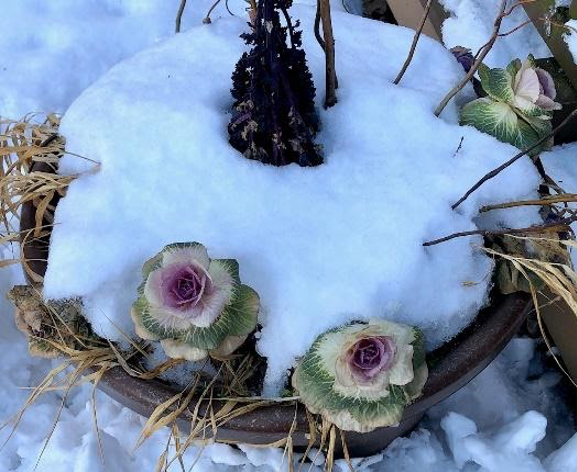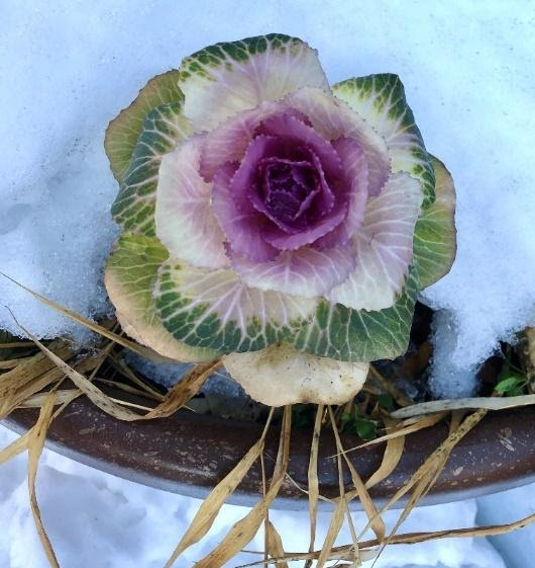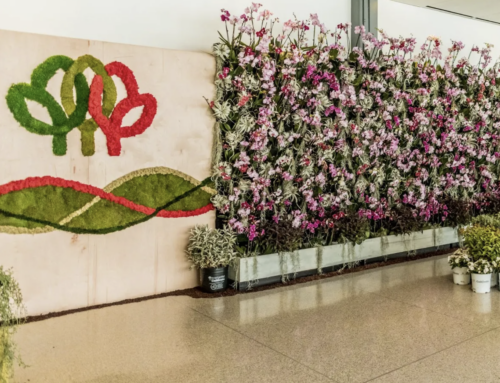If the Winter Solstice, December 21, is considered mid-winter, we are over that hump and moving spring-ward in the northern hemisphere. In the Great Lake States area, we have learned from years of experience, not to drop our guard – as well as gloves, boots, and warm coats for that matter. In fact, as we near the end of February, ice fishing is just getting underway in some areas of Michigan. With cold temperatures still lingering, it would be encouraging to see glimpses of color persevering in outdoor gardens.

In past years by late February, ornamental kales and cabbages have been known to wilt, lose color and turn mushy. Then when warm temperatures rise above 50 degrees F, the deceased cabbage can have an odor. Though cabbage coming out of winter thaw can have an unpleasant fragrance – it falls short of the Corpse Flower mentioned in a past posting. A comparative experience, for example, might be if you were strolling by what was a large planting of cabbage that had frozen (LET IT GO!). Now with plants slumped into mush as existing temperatures have exceeded 50 degrees F, you might think you’ve come upon a road-kill, a small one, like oh, maybe a squirrel. In comparison, the Corpse Flower can rise to the odor level of a dead cow on a steamy day in August.
Moving along, what is the cold weather threshold for ornamental kale and cabbage to no longer be considered ornamental?
At about 5 degrees F, kales’ and cabbages’ cell tissue collapse and the leaves succumb to the deep freeze.
Currently, in Western Michigan, temperatures have not dropped to 5 degrees yet, but we have experienced brutal winds, ample snow, and plenty of sub-freezing days and nights. So how has our ornamental cabbage withstood conditions this late in the winter? Note the image below – crisp leaves still arranged in the distinct rosette pattern and colors effectively persisting through the snow.

If you are truly looking for dependable plants to provide color and texture through most of the winter; ornamental kale and cabbage are tough to beat.
There are numerous varieties to consider. Here are some recommendations from the University of Wisconsin Master Gardeners:
- ‘Chidori’ Series – a mounded kale type with purple foliage that has extremely curly-leaf margins and a cream white or deep magenta center.
- ‘Color Up’ Series – a cabbage type with an upright growth habit with columnar type of appearance, green leaves, and colored center in white, blush pink or fuchsia.
- ‘Nagoya’ Series – round with heavily crinkled leaves and a tight rosette center that ranges in color from fuchsia pink, lavender, yellow-green to creamy white.
- ‘Osaka’ Series – very fast-growing and compact cabbage type with bluish-green, semi-waved leaves and a pink, red, or white center.
- ‘Peacock’ Series – these compact hybrids have deeply serrated, feathery red or white leaves.
- ‘Pigeon’ Series – look like flat heads of cabbage with red or white centers. They can be a single head or triple heads.
- ‘Tokyo’ Series – nearly perfectly rounded cabbage type with smooth, blue-green outer leaves and soft pink, red, or white centers.
-Rob McCartney, Horticulturist
Please feel free to contact me with any questions or for more info at:
Connect with us on social media!



